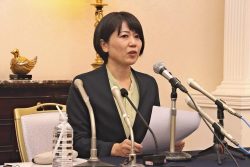
NuScale Power CEO Paul Lorenzini speaks during the Fortune Brainstorm Green conference in Dana Point, California April 13, 2010.
13:59 JST, June 24, 2021
The global trend toward decarbonization is leading to developers in Japan, the United States and Europe take a more serious look at small modular reactors (SMRs) for meeting energy demands.
Safer and more cost-effective, these next-generation nuclear power plants are expected to be put to practical use in the late 2020s.
Nuclear power plant makers in Japan are hoping that the move will lead to the revitalization of the stagnant nuclear power plant business in the country.
An SMR power plant has an output less than half that of a conventional plant, ranging from tens of thousands to hundreds of thousands of kilowatts. Some have an output of less than 10% of the existing reactor. SMRs are designed with an emphasis on safety measures, such as having light-water reactors partially submerged in a pool.
Because the main components of SMRs can be produced at factories and assembled on site, the construction costs can be reduced to about ¥100 billion, or 10% to 20% of the cost to build a conventional reactor.
Although SMRs are not yet in commercial operation, NuScale Power, LLC, a start-up backed by the U.S. government, is aiming for a start of operations in 2029. Heavy industry giant IHI Corp. and plant giant JGC Holdings Corp. are also participating in the project.
In the United States, where studies have been conducted on a number of furnaces, TerraPower, LLC., for which Microsoft Corp. cofounder Bill Gates serves as the chairman, is also advancing the SMR development.
Rolls-Royce Holdings PLC of Britain will begin the operation of an SMR power plant as early as 2029, and the Canadian government has also announced plans to begin operations in the late 2020s.
In Japan, Hitachi, Ltd. is jointly developing SMRs with General Electric Co. of the United States, and Mitsubishi Heavy Industries, Ltd. is studying an SMR power plant that can be relocated.
SMR power plants are attracting attention because they do not emit carbon dioxide during power generation and are expected to provide a stable supply of electricity while ensuring safety and economic efficiency.
After the 2011 accident at Tokyo Electric Power Company Holdings, Inc.’s Fukushima No. 1 nuclear power plant, the Japanese government has not changed its cautious stance on building new or additional nuclear power plants.
A person close to the government said, “If we fail to invest, we won’t be able to train engineers either,” indicating that the government will continue to support the development of next-generation nuclear power plants, including SMRs.

"Science & Nature" POPULAR ARTICLE
-

Mass Oyster Die-Offs Confirmed in Japan’s Seto Inland Sea; High Water Temperature Cited as Primary Cause
-

Genome Study Reveals Milestone in History of Cat Domestication
-

Big Leap in Quest to Get to Bottom of Climate Ice Mystery
-

Security Camera Footage Vulnerable to Outside Access; Investigation Finds 3,000 Pieces Exposed Online
-

Star-eating Black Hole Unleashes Record-setting Energetic Flare
JN ACCESS RANKING
-

Keidanren Chairman Yoshinobu Tsutsui Visits Kashiwazaki-Kariwa Nuclear Power Plant; Inspects New Emergency Safety System
-

Imports of Rare Earths from China Facing Delays, May Be Caused by Deterioration of Japan-China Relations
-

Japan Exports Rise in October as Slump in U.S. Sales Eases
-

Govt Aims to Expand NISA Program Lineup, Abolish Age Restriction
-

Blanket Eel Trade Restrictions Rejected


























